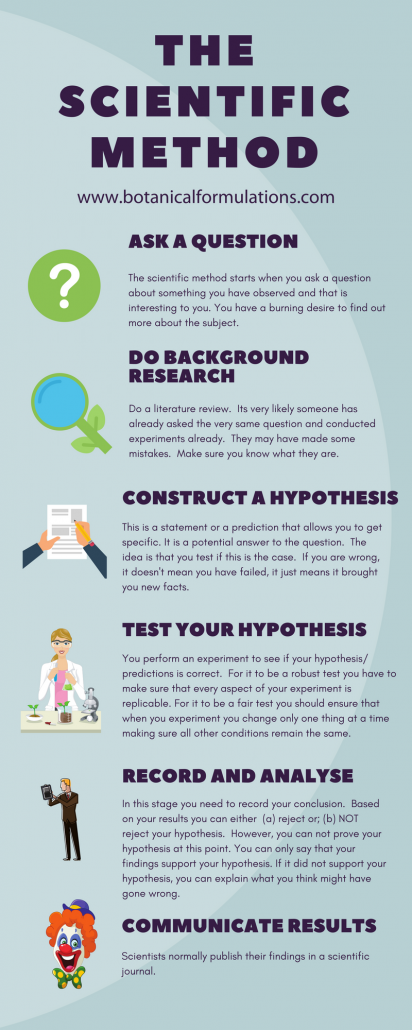The Scientific Method and Formulating Cosmetic Products
Having studied social sciences and humanities at post graduate level, I am well versed in the practise of primary and secondary research but I hadn't really needed to use the scientific method all that much. All I knew was this method wasn't of too much use when studying the complexities of societies or human nature. That said, I was probably introduced to the scientific method when doing some units in anthropology (which I loved) and I probably did it when studying sciences in school but until venturing into cosmetic science I had not practised the scientific method on any meaningful level.
I don't call myself a scientist but I do use this tool when formulating natural cosmetic products.
The scientific method is a valuable device for making products of a high standard; that can be made repeatedly and accurately. It is a way to be systematic when formulating cosmetics and should inform most of the stages from conception to bringing the final product to market.
So, what is the scientific method and how can it be used to make great products?
Broadly speaking, the scientific method is a set of stages a person goes through to test a claim or hypothesis. However, the stages are not linear in nature and can be adapted for distinct types of scientific inquiry.
Below is an infographic about the general steps within the scientific method:
How is the scientific method used when making cosmetic products?
When formulating it is important to experiment, observe and record in a methodical way. Below is an example to show how the scientific method can be utilised when developing cosmetic products.
HOW I USE THE SCIENTIFIC METHOD WHEN FORMULATING
So, I want to make a cream with a new emulsifier and I want to see how it will work with a high level of oil. I do the following:
Research the specific emulsifier. Peruse the supplier’s data/sell sheet as that will give lots of information. They have normally done a great deal of work testing their ingredient as they want to sell it. I usually take interest in things like the pH it works well at, what ingredients they advise to avoid or use minimal amounts of. I look at the processes and methods they employ and do a google search to find out if there are any products on the market that use this emulsifier. Often the ingredients list will give a lot of information, if you know what you are looking for.
Start formulating on paper (or excel sheet). I use the knowledge I have gleaned from the supplier’s research as well as my own experience. But, this is a starting formulation and must be made in order to know if the emulsifier works the way I want it to. It could be said that the paper formulation is my hypothesis.
Make a prototype. I carefully make a physical cream with the emulsifier, recording the method, conditions and details of how I make it, including any errors. The first formulation contains the recommended use rate for the quantity of oils used in the formulation, but it is an expensive emulsifier and I need it to be cost effective. I have to be aware that the company may also use the higher bracket of the emulsifier in their sales copy. On that basis I formulate the same cream with different levels of emulsifier to find the optimum level.
I do a stability test to see if the emulsifier works in my formulation. The one with the least emulsifier is not stable, it has separated however the others are fine. The stable one with the least amount of emulsifier is chosen. To ensure this is truly stable, it is made again and tested again.
But I keep thinking about the one that didn’t pass the stability test. I wonder, "Maybe it had nothing to do with the emulsifier, maybe it was something else? Instead of adding more emulsifier, maybe I could try something else?” I hypothesize what this might be and test it out again. I rewind back to stage 2. This might happen a few times while I try and trouble shoot especially if other things spring to mind.
Using the scientific method in formulating skincare is not difficult, providing good records and methodology are used. It is easy to have negative results with a formulation and be tempted to change a few things at once. I have been guilty of this myself.
Then again, there are also times when I know I am so far off the mark I end up using the experience of the first prototype to start all over again.


